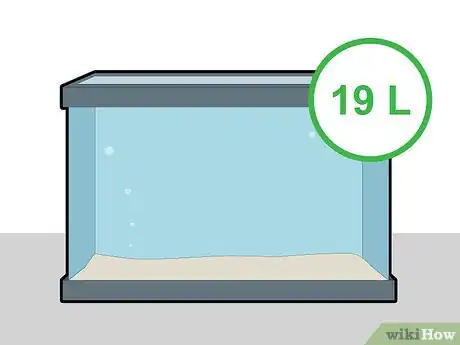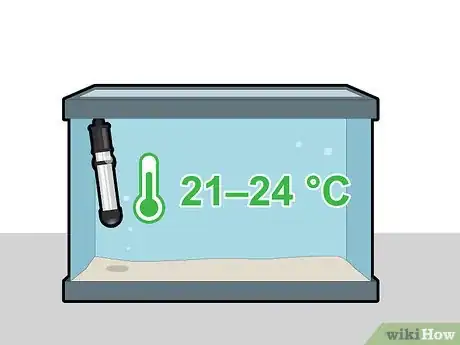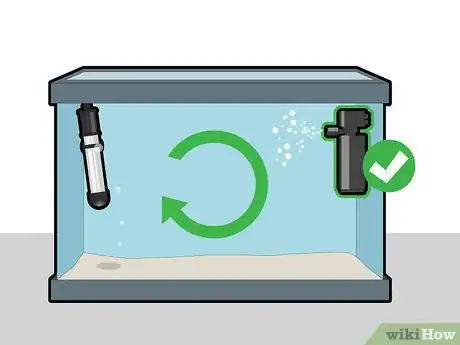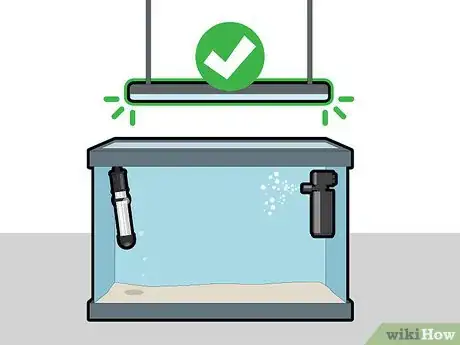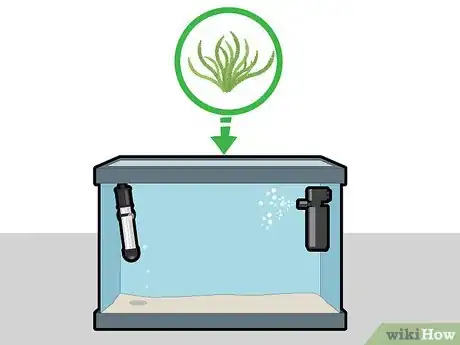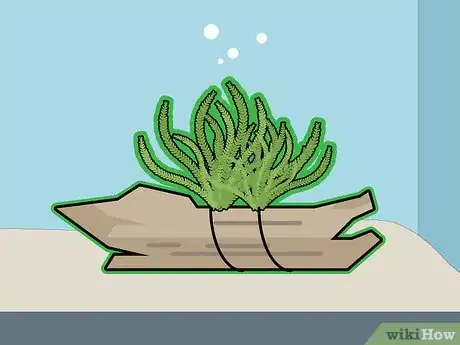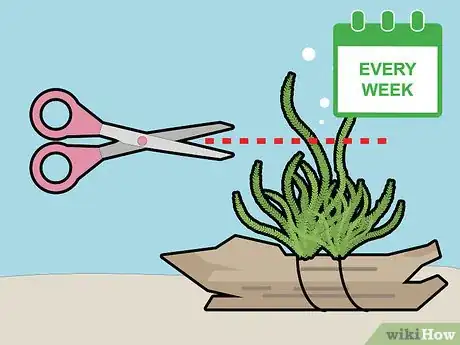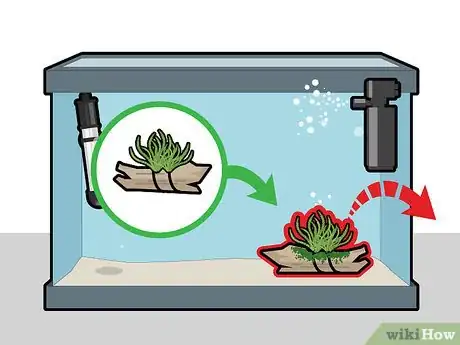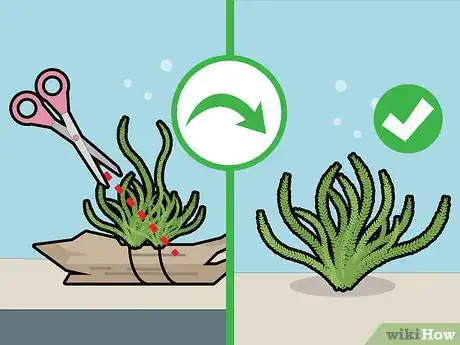This article was co-authored by wikiHow staff writer, Hunter Rising. Hunter Rising is a wikiHow Staff Writer based in Los Angeles. He has more than three years of experience writing for and working with wikiHow. Hunter holds a BFA in Entertainment Design from the University of Wisconsin - Stout and a Minor in English Writing.
This article has been viewed 77,360 times.
Learn more...
Java moss is a common aquatic plant used for decorating fish tanks and aquascaping. While considered an invasive species in the wild, java moss can be maintained in a tank.[1] It’s considered a great plant for beginners since it is easy to grow, compatible with most fish species, and low maintenance!
Steps
Setting up a Tank
-
1Use a freshwater tank larger than 5 US gal (19 L). Java moss cannot survive for long in marine aquariums, so make sure you have a freshwater tank ready. Tanks any smaller than 5 US gal (19 L) could crowd your fish as your moss starts to grow.[2]
- Java moss can survive slightly brackish water with a low salt content but prefers freshwater.
- Tap water should work fine, but you may need to add chemicals from an aquarium store to make it safe for plants and fish.
-
2Keep the water between 70–75 °F (21–24 °C). Place a heater in the tank so it stays at a consistent temperature. Java moss can tolerate temperatures up to 90 °F (32 °C), but it will cause it to grow much slower than the lower temperatures.[3]
- Check the temperature of your tank often to make sure it does not fluctuate. Many pet stores or aquarium shops will carry floating thermometers so you can easily check.
Advertisement -
3Maintain a water pH level between 5-8. Use a home pH test to check the acidity of your fish tank. If you find that the pH is off, you can add store-bought chemicals to raise or lower it to the desired level. Follow the instructions carefully when adding any chemicals to the tank.[4]
- Test kits or strips can be purchased at aquarium specialty stores or online.
- Adding shells or new rocks to your tank can help raise your pH if it is too low.
- Wood and moss will lower a high pH level.
- You should test the pH of the water once per week, especially when you perform a water change.
-
4Keep a filter in the tank to provide water circulation. Not only will it help keep your water clean, but a filter will create a current in your tank. Water circulation helps spread nutrients throughout the tank, making it easier for your moss to grow quickly.[5]
- A weaker current works best as the moss’s roots are establishing. A strong current could break apart moss and clog the filter.
- Keep the moss out of direct flow from the filter.
-
5Provide overhead fluorescent or LED lights. Java moss is not picky about its lighting conditions, but it will grow differently depending on the brightness. If you want your moss dense and to grow quickly, use bright lights. For thinner moss with a darker color, use low lights.[6]
- In a pinch, a desk lamp secured above your tank will work for a short amount of time.
- Brighter lights will cause more algae to form in your tank.
Adding Moss to Your Tank
-
1Drop the moss on top of the water if you want it to float. Leave a piece of the moss on the surface of the water. It will grow and develop into a floating plant. Be aware the moss will move around the tank and could catch in a filter.[7]
-
2Tie the moss to driftwood or a rock if you want it to adhere to something. Wrap dark thread or fishing line around a thin layer of the moss and tie a simple knot. The added security from the line will help the roots adhere to the rock or wood.[8]
- It takes about 1 month for the moss to adhere before you can remove the thread with a pair of scissors.
- Place a piece of driftwood upright and tie the moss to the top to make an underwater tree.
-
3Place the moss between 2 pieces of plastic mesh to make a wall or carpet. On one side of the plastic mesh, spread your moss as evenly as possible. Place the other piece of mesh on top. Use a needle and thread to tie the sides of the meshes together.[9]
- Lay the mesh on top of the substrate bottom to create a moss carpet.
- Attach suction cups to one of the mesh pieces and adhere it to one of the walls of your aquarium.
- Make sure the materials you use in your tank are non-toxic so it doesn’t contaminate the water.
-
4Don’t move the moss around once you put it in the tank. Once you put the moss in your tank, avoid disturbing it. It will take a couple weeks for it to fully adhere and become used to the conditions in your tank.[10]
- Different spots in your tank could affect the current or water flow and cause your moss to grow slower.
Caring for Java Moss
-
1Trim the moss every week with a clean pair of scissors. Reach into your aquarium and slowly cut if your moss is getting too long. Shape the moss however you want it. For example, if you have made a tree, you may want to make the moss round and neat.[11]
- You can let moss grow freely, but it may restrict water flow or make it hard for fish to move around your aquarium.
- Disinfect the scissors with warm water before putting them in your tank. Any added chemicals could harm the health of your plants and fish.
-
2Use a water siphon to change the water and vacuum the moss weekly. Move the siphon up and down in the water to create suction and start the water flow. Hold the siphon near your moss to suck any food or plant particles. Control the suction with your thumb at the end of the hose.[12]
- Have a bucket ready to drain 20 percent of the water from the tank.
-
3Replace the moss if algae start to grow on it. Algae forms in water with poor circulation and under bright lights. Though your moss will help prevent algae, it may get into your aquarium. Once algae have grown on your moss, it’s very hard to get rid of and should be removed.[13]
- If you are set on keeping the moss, gently use a soft toothbrush to scrub the moss. Be careful not to detach it from its base.
-
4Cut off pieces from the moss if you want to propagate it. Take any sized cutting from the moss with a pair of scissors and place it somewhere else in the tank. The cutting will form a new plant and continue to grow wherever it’s attached.[14]
References
- ↑ https://blog.aquariuminfo.org/java-moss-care-tips-moss-carpets/
- ↑ https://blog.aquariuminfo.org/java-moss-care-tips-moss-carpets/
- ↑ http://www.plantsrescue.com/tag/java-moss/
- ↑ https://www.ratemyfishtank.com/blog/properly-maintaining-the-ph-in-a-freshwater-aquarium
- ↑ https://blog.aquariuminfo.org/java-moss-care-tips-moss-carpets/
- ↑ http://www.plantsrescue.com/tag/java-moss/
- ↑ https://www.fishkeepingworld.com/java-moss/
- ↑ https://www.fishkeepingworld.com/java-moss/
- ↑ https://youtu.be/p-YCa0lT6JQ?t=2m33s
- ↑ https://www.fishkeepingworld.com/java-moss/
- ↑ https://www.fishkeepingworld.com/java-moss/
- ↑ https://blog.aquariuminfo.org/java-moss-care-tips-moss-carpets/
- ↑ https://www.fishkeepingworld.com/java-moss/
- ↑ https://www.fishkeepingworld.com/java-moss/
- ↑ http://www.plantsrescue.com/tag/java-moss/
- ↑ https://www.fishkeepingworld.com/java-moss/
About This Article
There are a variety of ways you can add java moss to your aquascape to make it more beautiful. If you want the moss to float on the water, simply drop it into the tank. Or, tie the moss to a piece of driftwood or a rock with some dark thread or fishing line. After about a month, the moss should stick and you can cut away the string. You could also spread the moss over a piece of plastic mesh, place another piece of mesh on top, and tie the sides of the meshes together with string to make a carpet on the floor of your tank. Because it takes a few weeks for the moss to adapt to the conditions in your fish tank, don’t move it around once you add it to your tank. Maintenance is pretty simple: trim it back every week or so with a pair of scissors and keep the water in the tank clean. For tips about how to propagate java moss, keep reading!
